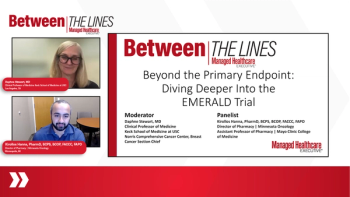
Experts Explore the Impact of Including PDTs within Treatment Selection for Behavior-Driven Disorders
Implementing prescription digital therapeutics can increase effectiveness of treatment pathways.
Episodes in this series

Megan Coder, Pharm.D, M.B.A.: When we’re comparing digital therapeutics with traditional care, we’ve spoken a lot about the notion of clinician-delivered care, with in-person CBT [cognitive behavioral therapy] and other therapies. We’ve talked a little about pharmaceuticals. But when you’re trying to compare them, are there different things that stand out to you about why digital therapeutics have more value? Maybe it’s related to patient-centered care or other aspects, but I’m curious to hear your perspective on how different or similar digital therapeutics are from traditional care.
Arwen Podesta, M.D.: I want to be sure we’re clarifying that the prescription digital therapeutics [PDTs] are used as a treatment arm. They’re not replacing traditional drug therapy but augmenting and helping in retention, at least the majority of PDTs I’m using. They’re not replacing a clinician or a prescriber; this is a prescription. They’re not replacing a therapist. That’s something I want to talk about. There’s definitely a bit of fear or a challenge in the prescribing world because of many barriers to access but also because one might perceive, without knowing much about these PDTs, that they’re taking my job away. That’s absolutely not the case. They’re an augmentation. They enhance adherence, retention and success, so it doesn’t compare. We’re not doing a head-to-head study between medication-assisted treatment for opioid use disorder and a PDT. We’re doing a combination of the PDT plus medication-assisted treatment vs. medication-assisted treatment only. We see improved outcomes.
I support these tools 100%. [A PDT] a very patient-centered tool because the patient is only in front of me once a week or once a month, or in front of their therapist once or twice a week, or with group therapy three times a week in an intensive outpatient program. They’re at home or out in the world the rest of those hours. How many hours are they on their phone, on their device? I’m on my device for four to six hours. Patients might be on them longer or shorter, but having an extension of their treatment on that device that they’re always on is a wild improvement in our ability to be a part of the patient’s lifestyle.
Megan Coder, Pharm.D, M.B.A.: That’s well said. Paul, we’ve been talking about how you, as a payer, are starting to evaluate digital therapeutics and their impact. When you’re looking at that process that you use to cover traditional drugs or therapies, are those processes very similar to what you’d use for the PDT space? Or is it a very different intake process for the evaluation for prescription digital therapeutics?
Paul L. Jeffrey, Pharm.D: We heavily rely on a tried-and-true process for evaluating new-to-market therapies. At MassHealth, my team was responsible for evaluating a significant array of products. The way payers may think about certain things depends on their channel of distribution; that’s one way. If it’s a pharmacy item, that’s one thing. If it’s a medical drug, that’s a different thing. If it’s a medical device that moves through the pharmacy channel, that’s different from a medical device that’s used in a physician’s office or separately by the patient.
Along the way, our program did more health technology assessments writ large. We developed a process for evaluating the literature and the evidence and took it through a process for what that looks like when we adopt it, in terms of utilization parameters and impact. For example, with a prescription digital therapeutic, it would be assigned to a member of our team. We have a clinical pharmacist and a pharmacoeconomist who would look at those products the same way they would look at a drug. They would start with what’s evidence based and then socialize with key opinion leaders about whether they would use this thing if it were available to them. Then we have a projection of uptake and financial impact. The financial impact would be a value proposition. We’ve moved our thinking away from the cost of the drug to the impact of the drug on the overall cost of care.
As an aside on prescription digital therapeutics, when we adopted the reSET and reSET-O onto our formulary, it was with the expectation that that would reduce the overall cost of care in the patients who used it. We had that expectation, and we’re doing evaluations to see if that turned out to be the case. It’s a different animal, but it’s still an animal if you will; that’s an awful analogy. We’re working through the process, but we still use the same tried-and-true methods that we have developed and become experts at over the years.
Transcript edited for clarity.
Newsletter
Get the latest industry news, event updates, and more from Managed healthcare Executive.




















































